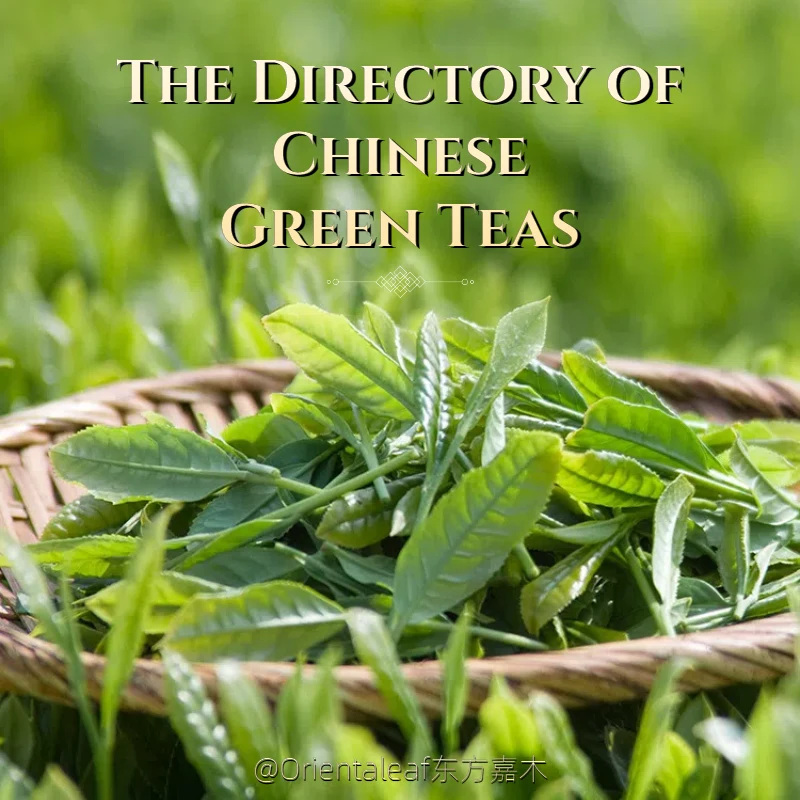Welcome to the The Directory of Chinese Green Teas!
You’ll find a quick reference guide to some of the most iconic Chinese green teas here. Each entry includes its English name, Chinese characters, pinyin, origin, and key features—perfect for tea enthusiasts and curious learners alike.
West Lake Longjing Tea
| Attribute | Details |
|---|---|
| English Name | West Lake Longjing Tea/ Dragon Well Tea |
| Chinese Name | 西湖龙井茶 |
| Pinyin | Xī Hú Lóng Jǐng Chá |
| Origin | West Lake area, Hangzhou, Zhejiang Province |
| Appearance | Flat, smooth, green leaves |
| Key Features | Fresh, nutty aroma with a hint of sweetness |
| Harvest Time | Spring (mainly March to April) |
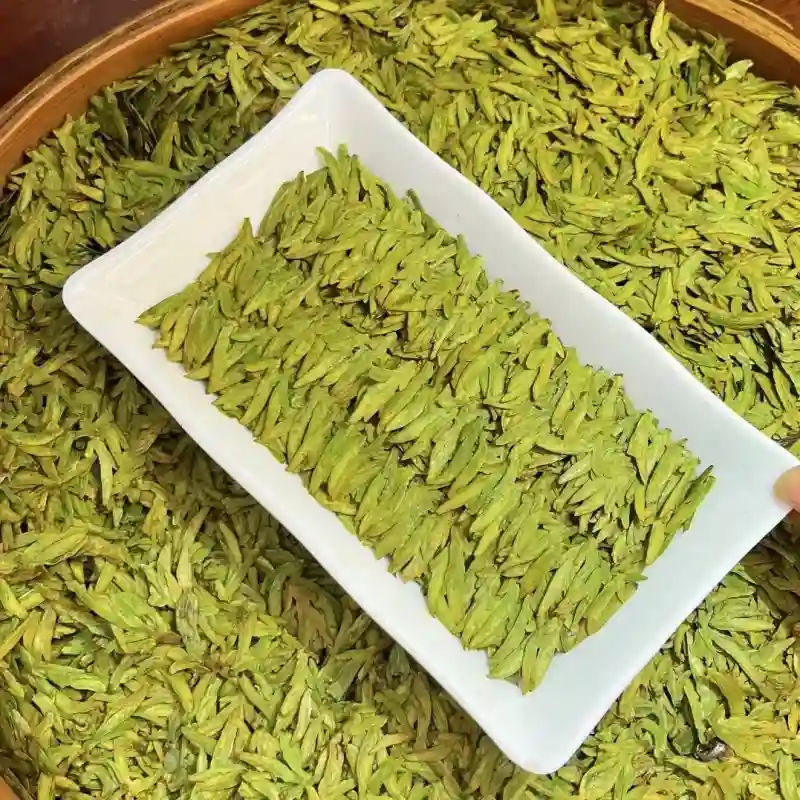
Historical and Cultural Stories
- Early History: Tea production in the West Lake area dates back to ancient times. Lu Yu’s “The Classic of Tea” mentions tea from Tianzhu and Lingyin temples in Qiantang. Another theory suggests that poet Su Shi brought tea trees from Tiantai Mountain to West Lake in the Southern Dynasty.
- Tea Evolution: The flat-shaped tea we know today likely began evolving in the Ming Dynasty. Peng Sunyi’s “Tea Picking Song” (late Ming) refers to flat-shaped tea, marking a significant step in the development of Longjing tea.
- Royal Endorsement: Longjing tea gained fame due to Ming Dynasty figures like Huang Yifei and Xu Wei. Emperor Qianlong further boosted its status with his multiple visits to West Lake and admiration for the tea.
Grade Division
- Historic Grading: Traditionally, Longjing tea was classified into four grades: Lion, Dragon, Cloud, and Tiger. After 1949, it was simplified into three categories: Shifeng Longjing, Meijiawu Longjing, and West Lake Longjing.
Processing Technology
- Initial Processing: Fresh leaves are spread, fried, and processed through various steps like polishing and drying to preserve quality. The intricate frying technique involves ten specialized movements to perfectly shape the leaves.
- Refined Processing: After initial frying, Longjing tea undergoes sorting, winnowing, and polishing to enhance the leaf shape and ensure consistency in quality.
Quality Characteristics
- Leaf Appearance: Longjing tea leaves are flat, smooth, and uniform in shape, with a green and moist color.
- Taste and Aroma: Known for its fresh and mellow taste, it has a long-lasting fragrance. The tea’s liquid is tender green, with a vibrant color and a soothing flavor that has earned it a reputation for its four excellent qualities: green color, strong aroma, mellow taste, and beautiful shape.
Jingshan Tea
| Attribute | Details |
|---|---|
| English Name | Jingshan Tea |
| Chinese Name | 径山茶 |
| Pinyin | Jìng Shān Chá |
| Origin | Jingshan area, Yuhang District, Hangzhou, Zhejiang Province |
| Appearance | Thin, slender, slightly curled leaves with a fresh green color |
| Key Features | Light, delicate taste with a mild, refreshing aroma |
| Harvest Time | Spring (mainly March to April) |
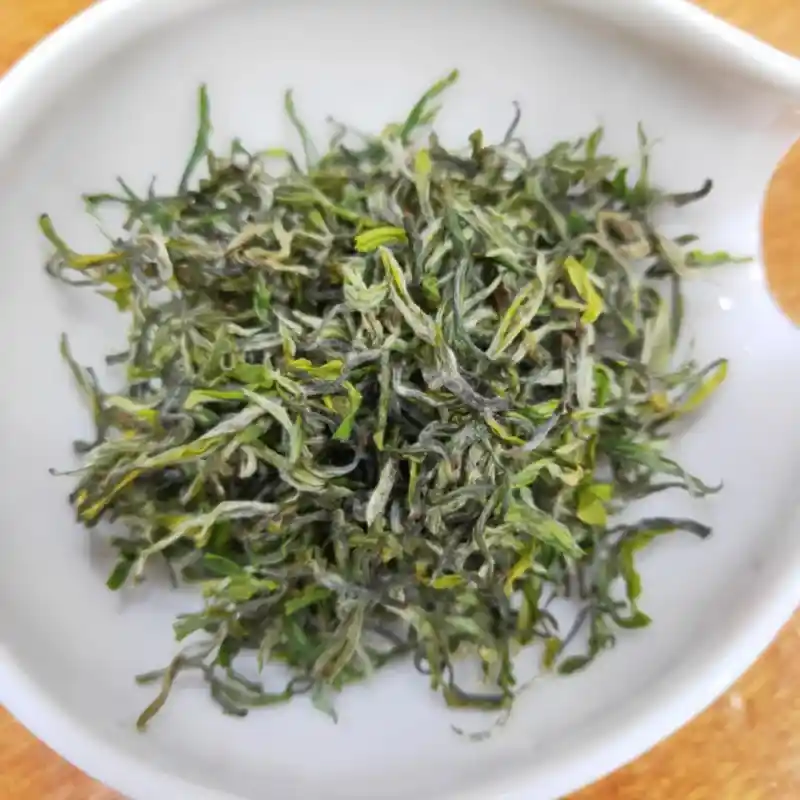
Origin and History:
- Creation in the Tang Dynasty: Jing Shan Tea has a long history, dating back to the Tang Dynasty (742 AD). It was initially created by Monk Faqin, who planted tea trees in the Jing Mountain area.
- Modern Revival: After a period of decline, production resumed in 1978, reviving this historical tea.
Geographical and Environmental Conditions:
- Location: Jing Shan Tea is grown in Yuhang District, Hangzhou City, Zhejiang Province, in the northeastern part of Zhejiang. It is situated in the Huangshan Mountain range and is influenced by the monsoon climate transitioning from mid-subtropical to north-subtropical.
- Climate: The region experiences an annual average temperature of 16°C, abundant rainfall (over 1400 mm annually), and about 1944.6 hours of sunshine annually, creating an ideal environment for tea growth.
- Soil: The region is rich in yellow-red soil, contributing to the high quality of the tea, with good organic content and deep soil layers.
Processing Technology:
- Spreading: Fresh tea leaves are spread for 6 to 12 hours until they lose around 30% of their water content, becoming soft and releasing a clear fragrance.
- Fixation: This process can be done manually or mechanically to preserve the tea’s emerald color and delicate fragrance. Manual fixation involves stir-frying the leaves in a 64 cm frying pan at 120-130°C for 10 to 15 minutes, while mechanical fixation uses a specialized machine.
- Stripping and Shaping: After fixation, the leaves undergo stripping and shaping to further reduce moisture content and straighten the leaves.
Unique Features:
- Flavor: Jing Shan Tea has a mild, delicate flavor with a refreshing aroma, making it a popular green tea variety.
- Revival: The tea’s revival in modern times shows its lasting appeal and historical significance.
Changxing Purple Bamboo Shoot Tea
| Attribute | Details |
|---|---|
| English Name | Changxing Purple Bamboo Shoot Tea |
| Chinese Name | 长兴紫笋茶 |
| Pinyin | Cháng Xìng Zǐ Sǔn Chá |
| Origin | Changxing County, Zhejiang Province |
| Appearance | Thin, slender, slightly curled leaves with a subtle purple tint and fresh green color |
| Key Features | Sweet, refreshing flavor with a slight floral note, mellow taste |
| Harvest Time | Early Spring (mainly March to April) |
| Aroma | Fresh, floral, with a subtle vegetal fragrance |
| Flavor | Light and delicate, with a refreshing and smooth aftertaste |
| Brewing Method | Water Temperature: 75-80°C (167-176°F); Steeping Time: 2-3 minutes |
| Health Benefits | Rich in antioxidants, promotes digestion, boosts immunity, and improves skin health |
| Tea Liquor Color | Clear, light green |
| Leaf Characteristics | Tightly rolled, tender, with a slightly purple hue |
| Geographical & Environmental Conditions | Grown in high-altitude, fertile soil areas with a mild climate in Changxing County |
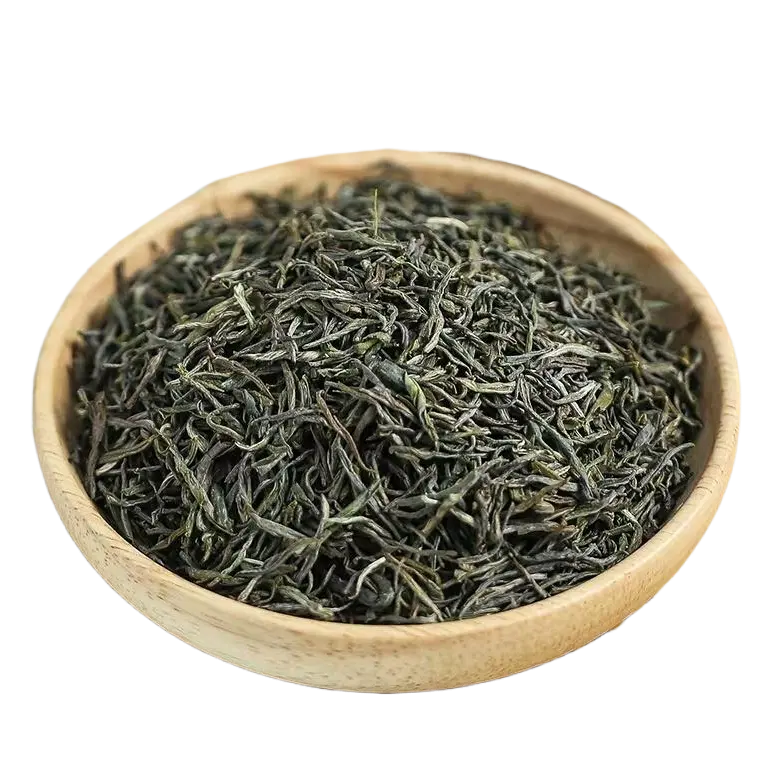
Changxing Zisun Tea is a unique green tea from Changxing County in Zhejiang Province. It is celebrated for its fresh taste and delicate flavor, and has gained popularity among tea enthusiasts. This tea not only has a long history but also boasts a unique production process and geographical environment. Below is the description of the origin, history, natural conditions, processing methods, and unique features of Changxing Zisun Tea, written in a fun and easy-to-read way.
Origin and History
The history of Changxing Zisun Tea dates back to the Tang Dynasty, when tea culture began to flourish in China. It is said that Changxing Zisun Tea was first discovered by local farmers who realized that the climate and soil conditions in Changxing County were perfect for tea cultivation. Particularly, tea trees grown in the high mountains produced excellent-quality leaves. Over centuries, this tea evolved and became a specialty product of the region.
During the Song Dynasty, Changxing Zisun Tea was included in the royal tribute list. Its production process became more refined, and its flavor grew richer and fresher. Today, Changxing Zisun Tea still retains its traditional production methods, while also evolving to meet the demands of modern consumers.
Geographical and Natural Conditions
Changxing Zisun Tea is produced in Changxing County, located in the Taiping Lake Basin of Zhejiang Province. The climate here is mild and humid, with distinct seasons. The average annual temperature is around 15°C, with ample rainfall, especially in spring, providing ideal conditions for the growth of tea trees.
The tea gardens are typically situated in mountainous areas above 500 meters in elevation. The soil here is mainly red and yellow soil, rich in organic matter, well-drained, and loose, which greatly contributes to the quality of the tea leaves, making them tender, fragrant, and vibrant.
Processing Techniques
The production of Changxing Zisun Tea follows traditional handcrafting methods, involving steps like picking, withering, pan-firing, rolling, and drying. Since Changxing Zisun Tea leaves are delicate and have a slight purple hue, the picking process is particularly important. Every spring, tea pluckers start early in the morning to hand-pick the tender buds, ensuring each leaf is fresh and tender.
During processing, the tea leaves are first spread out to remove excess moisture. Then, the leaves undergo a critical pan-firing step to lock in their freshness and aroma. Finally, they are rolled and dried, resulting in the tea’s distinctive long, slender shape.
Unique Features
The most distinctive feature of Changxing Zisun Tea lies in its fresh and delicate taste. The tea soup is clear and bright, with a vibrant green color. When sipped, it offers a natural sweetness and a refreshing aftertaste. The tea’s aroma is fresh and long-lasting, with floral and grassy notes that seem to capture the essence of nature.
Additionally, the leaves of Changxing Zisun Tea are thin and bamboo-like, with a subtle purple tint, which is where the name “Zisun” (meaning purple bamboo) comes from. This unique leaf shape and color make the tea visually appealing and enhance its overall charm.
Changxing Zisun Tea, as a local specialty of Zhejiang Province, boasts a rich history and favorable natural conditions. Its production process is intricate and meticulous, ensuring the tea’s high quality and unique flavor. Whether in its fragrance or taste, Changxing Zisun Tea offers a refreshing and comfortable natural experience. This tea is not only a pride of Changxing but also a treasured part of Chinese tea culture.
Golden Award Huiming Tea / Jinjiang Huiming Green Tea
| Attribute | Details |
|---|---|
| English Name | Jinjiang Huiming Green Tea/ Golden Award Huiming Tea |
| Chinese Name | 金奖惠明茶 |
| Pinyin | Jīn Jiāng Huì Míng Chá |
| Origin | Jingning County, Zhejiang Province, China |
| Appearance | Plump, tight shape with bright emerald green color |
| Key Features | Lasting fragrance, fresh and mellow taste, fruity aftertaste, no bitterness despite strength, resistant to brewing, remains flavorful across multiple infusions |
| Harvest Time | Around the Spring Equinox (mainly March) |
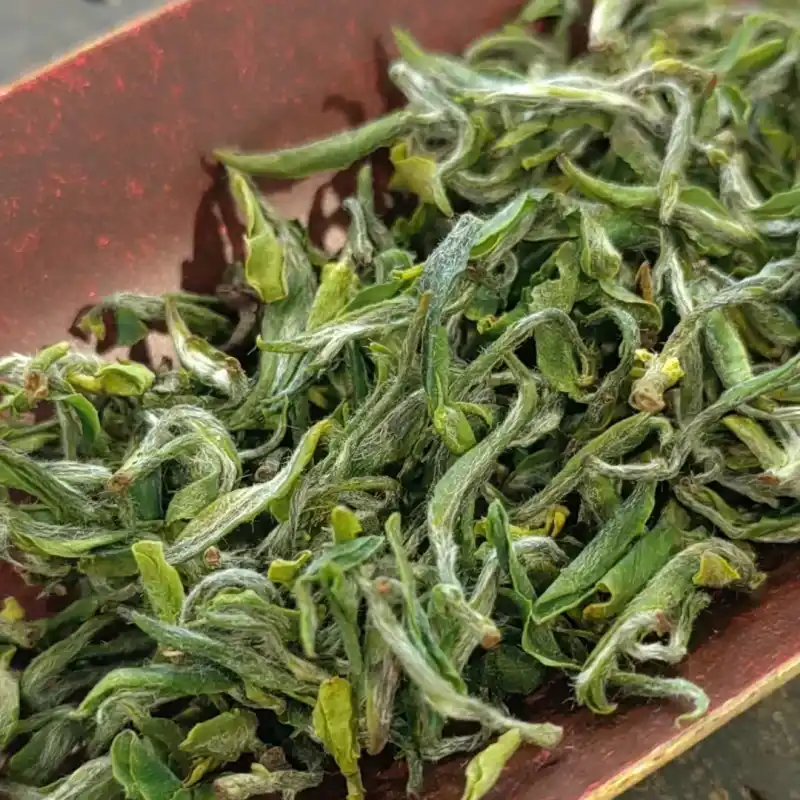
Historical and Cultural Stories:
- Produced in Jingning County, Zhejiang Province, China. Its original area was around Chimushan 赤木山 Jitou 际头 and Huiming Temple惠明寺. In the early Tang Dynasty, a monk named Huiming 惠明 built a temple here, and the tea got its name from him and the temple. It’s a restorative historical famous tea, restored in 1971.
- In the 18th year of Chenghua 成化 in the Ming Dynasty (1482), it was listed as tribute tea with an annual tribute of two catties of tea buds. The poet Yan Yongguang (严用光)’s “Huiming Tea Song惠明茶歌” mentioned its rarity in the capital. In 1915, it won the Gold Medal and First-Class Certificate at the Panama-Pacific International Exposition in New York, USA, and became famous worldwide but was once lost. This is also how the name “Golden Medal Huiming Tea” came to be.
Geographical and Environmental Conditions:
- Jingning County is in the southern part of Zhejiang, with a latitude from 27°39′ to 28°11′ and a longitude from 119°14′ to 119°58′. It’s a typical mountainous county with mountainous areas over 95% of the total area (1949.98 square kilometers). The terrain slopes from southwest to northeast, with the highest peak (Shangshantou) at 1688 meters and Yuekou Village at about 70 meters, an altitude difference of 1618 meters. The altitude is generally 500 – 800 meters with three types: mountainous areas, terraces, and valleys. The main production area of Jinjiang Huiming Tea is at 500 – 700 meters altitude with an annual precipitation of 1876 mm, average annual air humidity of 80% – 88%, and 144 foggy days.
- Granite and limestone areas account for 95.1% of the county. The soils in middle and low mountain areas are mainly yellow sand soil, sandy clay red soil, and red pine mud. The main soil in the production area is yellow-red sandy soil and sandy clay red soil formed by granite and schistose rocks weathering, with a soil layer depth over 1.5 meters, strong sandiness, high fertility, good water retention, average sand content of 35% – 53%, slightly acidic, organic matter content in mountainous areas of 2% – 8%, available phosphorus of 4 – 5 mg/kg, available potassium of 80 – 150 mg/kg, and pH of 4.5 – 5.6.
Raw Materials and Picking Requirements:
- Uses local Huiming group varieties like large-leaf species, Chu-leaf species, middle-leaf species, multi-bud tea, and white-bud tea. Large-leaf species are the main raw materials for high-quality tea.
- Picked around the Spring Equinox, requiring fresh leaves to be tender (mainly one bud and one leaf), uniform in size and length, fresh (clean and breathable basket, no pressure on leaves, no rainwater or dew leaves, processed on the same day), and clean (no purple buds, weak buds, pest and disease buds, no fish leaves, single pieces, scales, tea seeds, old branches, old leaves, etc.).
Processing Technology:
- Traditional Handmade Processing Technology: Includes spreading, fixation, kneading, shaping, cooling, drying, and sorting and storage.
- Spreading: Fresh leaves are spread indoors with a thickness of about 5 cm for 4 – 6 hours, lightly turned several times until they lose luster and emit new tea fragrance.
- Fixation: In an inclined pan, wipe a small amount of tea oil when the temperature rises. When the pan temperature is 150°C – 170°C, put in 200 – 300 grams of spread green leaves. Use a combination of shaking and covering, more shaking and less covering, with an open hand gesture to ensure even and thorough fixation for 5 – 6 minutes.
- Kneading: Put slightly cooled fixation leaves on a clean bamboo curtain and rotate clockwise with both hands, following the “light, heavy, light” principle. Knead until the tea juice slightly overflows and the strip forming rate is over 80%, usually taking 2 – 3 minutes.
- Shaping: In an inclined pan, gently grasp and roll the tea buds and leaves in the same direction to dissipate moisture until they don’t stick to hands, can be held into a ball and scattered immediately when thrown.
- Hair Raising and Shaping: The pan temperature is 80°C – 90°C. Oppose the palms and slightly bend the four fingers. Roll the tea repeatedly in the pan. When the tea is 70% dry, lower the pan temperature to about 60°C. Hold the tea with one hand and rotate along the pan wall in the same direction to make white hairs appear and the tea strips tighten and slightly curl.
- Cooling: Take out the tea embryos after hair raising and shaping and cool for 20 minutes to make the moisture content uniform.
- Drying: Put the cooled tea embryos into an inclined pan and dry gently and frequently until completely dry to promote emerald green color and high fragrance and protect pekoe.
- Sorting and Storage: Sort, screen, dedust, and cool the dried tea leaves, then store in separate files in sealed containers in a clean, dry, and dark place to prevent air leakage.
- Current Mechanical Processing Technology: Includes spreading, fixation, kneading, initial drying, baking and shaping, and final drying and fragrance enhancement.
- Spreading: Same as the handmade process.
- Fixation: Use a 30 or 40-type drum fixation machine at 200°C – 230°C with a leaf input of 500 grams per minute. The fixation should be old killing, with leaves having slight popping points, feeling fragile, and stems soft and not easy to break. After coming out, cool with a fan and thinly spread on a clean bamboo mat. Knead when hands feel soft and stems don’t break after full moisture regain.
- Kneading: Use a 35 or 45-type kneading machine with a leaf input of 6 – 10 kilograms. Load the leaves to a depth of 3 – 5 centimeters shallower than the bucket mouth without overfilling. Knead following the “light, heavy, light” principle for 15 – 20 minutes until the strip forming rate is about 80%, with no juice extrusion and no obvious agglomeration. Disassemble the blocks in time after getting off the machine.
- Initial Drying: Use a CR-3 continuous dryer with high temperature, fast speed, and thin spreading at 110°C – 120°C for 3 – 4 minutes. The leaves should feel slightly touched, not agglomerate, and turn dark green. Then thinly spread it on a clean bamboo mat for moisture.
- Baking and Shaping: On a four-bucket baking machine, put about 1.5 kilograms of initial drying leaves in each bucket at 80°C – 90°C. While baking, rub and lift the leaves in the same direction to form a relatively tight shape and show the hair. Take off the machine and cool when 80% dry.
- Final Drying and Fragrance Enhancement: Dry on a dryer at 120°C for 25 – 30 minutes. Take off the machine, cool, and pack into boxes when pinched into powder.
Grade Division:
Sets Te – 1, Te – 2, and Te – 3 as high-grade famous teas; 1 – 2 grades as medium-grade famous teas; and 3 – 4 grades as low-grade famous teas.
Quality Characteristics:
Has a plump and tight shape, bright emerald green color, clear and bright soup color, high and lasting fragrance, fresh and mellow taste, not bitter despite being strong, good aftertaste, fruity taste, good mouthfeel, resistant to brewing, with the characteristics of one cup being fresh, two cups being strong, three cups being sweet and mellow, and the tea charm remaining in the fourth and fifth cups.
Songyang Silver Monkey Tea
| English Name | Songyang Silver Monkey Tea |
|---|---|
| Chinese Name | 松阳银猴茶 |
| Pinyin Name | Sōngyáng Yínhóu Chá |
| Origin | Songyang County, Zhejiang Province, China |
| Appearance | Fat and strong strips, white hairs exposed |
| Main Characteristics | Long-lasting chestnut aroma, rich and fresh taste, green and bright soup color, tender green and bright leaf bottom |
| Harvest Time | One bud with one leaf just unfolding |

I. The Origin and History of Songyang Silver Monkey Tea
- Origin: Songyang Silver Monkey Tea is produced in Songyang County, Zhejiang Province, located in the southwestern part of Zhejiang, upstream of the Oujiang River, between 119°10′ to 119°42′ E longitude and 28°15′ to 28°37′ N latitude.
- Climate Characteristics: The region has a mid-subtropical monsoon climate with distinct seasons, abundant rainfall, mild winters, and early springs. It has a long frost-free period, with an annual average temperature ranging from 14.2℃ to 17.7℃. The average temperature in January is 6.3℃, and in July, it is 28.1℃. The accumulated temperature above 10℃ is between 4453℃ to 5634℃. The area enjoys 206 to 236 frost-free days per year, 1600 to 1848 hours of annual sunshine, and an average annual rainfall of 1511.6 to 1844.9 millimeters. There are 171 rainy days annually, with concentrated rainfall in spring and summer. The average relative humidity is 75%, and there is ample diffuse light.
- Topography: The region belongs to the Zhejiang-Fujian hilly area with complex and diverse topography, mainly consisting of basins, hilly valleys, low mountains, and mid-mountains. The soil types are primarily red soil and yellow soil with a pH of 4.5 to 5.5, organic matter content of 2% to 3%, and deep soil layers generally above 50 centimeters with loose structure.
- Historical Background: Songyang has a long history of tea production, dating back to the Three Kingdoms period. During the Tang Dynasty, the famous Taoist master Ye Fashan cultivated tea trees in the fertile soil of Maoshan Mountain in Songyang. The tea produced was named “Immortal Tea” and became a tribute to the royal family, gaining great popularity.
II. Creation and Honors of Songyang Silver Monkey Tea

- Creation Time: Songyang Silver Monkey Tea was newly created in 1981.
- Awards: It has won the Zhejiang Province First-Class Famous Tea Award for three consecutive years. In 1984, it was recognized as “Zhejiang Famous Tea” and won the title of “Top Ten Teas in Zhejiang Province” in 2004 and 2009.
III. Raw Materials and Harvesting Standards of Songyang Silver Monkey Tea
- Raw Materials: The tea is made from young buds and leaves of the multi-hair type Silver Monkey variety.
- Harvesting Standards: The standard for harvesting is one bud and one leaf just beginning to open. The buds should be longer than the leaves, uniform in size, and consistent in tenderness. Leaves affected by pests, damaged leaves, scales, and fish leaves should not be picked.
IV. Processing Techniques of Songyang Silver Monkey Tea
- Processing Procedures: The processing includes spreading, fixation, rolling, shaping, and drying.
- Spreading: Fresh leaves are spread thinly on bamboo mats to a thickness of 1 to 1.5 centimeters for 8 to 10 hours, with 2 to 3 turnings in between. When the leaf surface loses its gloss and emits a fresh fragrance, fixation begins.
- Fixation: Fixation can be done manually using a flat pan or with a 40-type drum fixation machine. For manual fixation, the pan temperature is around 150℃, with a leaf input of 100 to 500 grams. For drum fixation, the drum temperature is between 180℃ to 280℃, with an hourly input of 35 kilograms for the 40-type drum machine. The fixation process aims to eliminate the grassy smell and produce a fresh aroma.
- Rolling: Rolling can be done manually or with a 30-type or 45-type rolling machine. Manual rolling involves placing the cooled fixed leaves on a rolling tool and gently rolling them into strips with both hands in a consistent direction. The leaves are scattered 2 to 3 times during the process until tea juice slightly oozes out, and the strip formation rate exceeds 95%.
- Shaping: Shaping is a key process to create the beautiful appearance of Silver Monkey Tea. The pan temperature is maintained between 80℃ to 100℃. The leaves are shaped by grabbing, shaking, pushing, and rubbing techniques. The shaping process should be gentle to avoid losing the white hairs or changing their color. When the leaves are 80% dry and form the unique straight shape with silver hairs, they are taken out and cooled.
- Drying: Drying can be done manually or with machines and includes initial and final drying stages. Manual drying involves placing cooled tea leaves on bamboo trays and drying them with low heat (60℃ to 65℃) until 90% dry, then cooling and continuing drying until the leaves are completely dry with a moisture content below 5%. Machine drying involves initial drying at 110℃ to 120℃ for 5 to 6 minutes and final drying at 90℃ for about 15 minutes until the leaves are completely dry and crumbly.
V. Quality Characteristics of Songyang Silver Monkey Tea
- The tea leaves are plump and covered with white hairs, emitting a lasting chestnut fragrance. The taste is rich and fresh, the tea soup is green and bright, and the infused leaves are tender and green.
We serve thousands of satisfied tea enthusiasts in our tea house each year, and we’re excited to share these exceptional teas with tea lovers worldwide at Orientaleaf.com.

